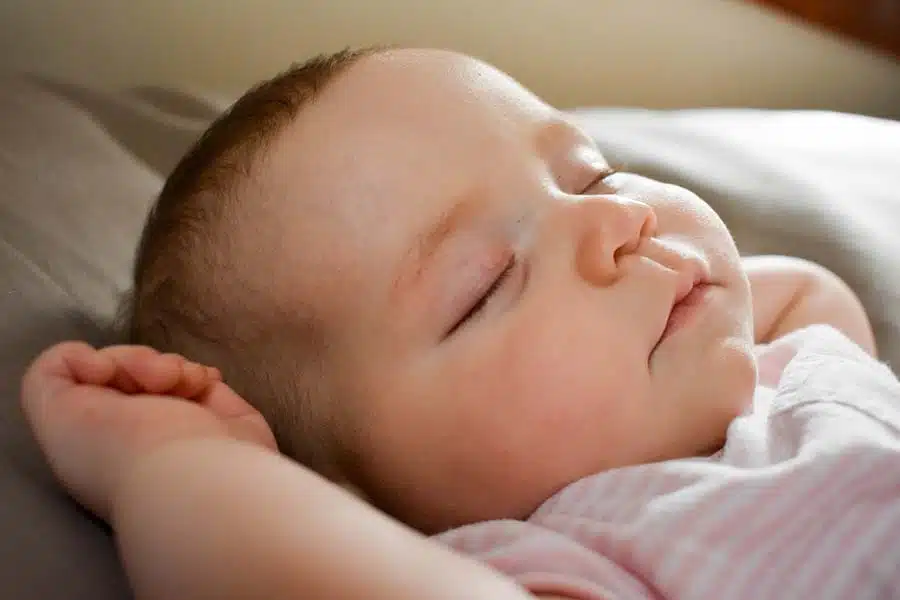Was your baby born with a flat head, or have they developed one in their first few months post-birth? If so, don’t panic! We’re here to help and offer you some peace of mind.
Children born with a flat and/or a misshaped head are suffering from plagiocephaly, a condition that is more common in babies than one might think. This condition can spark a ton of concern in parents. Thankfully, there are plenty of treatment options out there that can help your child correct the issue and get back to normal development.
Let’s take a closer look at the causes behind plagiocephaly in babies, and our top tips for addressing the issue.
What Is Plagiocephaly, and What Causes It in Babies?
Plagiocephaly, sometimes referred to as flat head syndrome, is a condition where part of a baby’s head is flattened or misshaped. Typically, this is the back and/or sides of the head.
When a baby is born, their skull is thin, pliable, and soft, giving the baby’s head more flexibility to fit through the vaginal canal during birth. In fact, it’s common for most vaginally delivered babies to have a slightly misshaped head for the first six weeks of life.
Plagiocephaly can also happen as a result of too much pressure on the head during the first few months of life, usually during sleep, because of the skull’s pliability. This happens when there is too much pressure on the head while the baby is lying on their back for an extended period of time. As such, it is common to see plagiocephaly in children who spend long periods of time on their backs.
Causes for Concern With Plagiocephaly
If your child’s head is misshaped as a result of vaginal birth, the condition should correct itself within six weeks.
However, if it has been six weeks and your child is still going through the issue, it may be time to seek medical help from a paediatric physiotherapist. When it comes to this condition, early intervention is key. Don’t wait, as physiotherapy intervention for this condition while a child’s skull is still in its more pliable state is key for a good recovery.
While this condition doesn’t cause pain and shouldn’t cause a brain developmental delay or other child development issues, it can lead to other causes of concern. These include:
Changes In Your Child’s Appearance
The biggest issue for most parents is the way this condition can affect your child’s appearance. When left untreated, plagiocephaly can leave a child with a flat area on the skull, causing an overall asymmetrical head shape. It can also lead to a noticeable swoop or tile to one side, a tilted head, or uneven looking ears.
Developing Torticollis
Having this condition can also lead to the development of torticollis. Torticollis, sometimes referred to as wryneck, is a condition where your child will have tightened, or even shortened, muscles on one side of the neck. When living with this condition, your child will have neck tightness and tilt their head to one side. Torticolis may also be the underlying cause of your baby developing plagiocephaly, as they tend to have a postural head preference.
To address this, parents will need to seek paediatric physiotherapy, to help stretch out and relax the muscles causing the head tilt.
How is Plagiocephaly Diagnosed?
In many cases, plagiocephaly will be diagnosed by health professionals, usually a paediatric physiotherapist, with a physical exam.
Health professionals will first assess your child’s face, looking at face shape, symmetry, and signs of skull flatness. They may also look at the head and neck muscles as well as the hips and lower limbs for an overall gross motor skills assessment. This includes looking at a child’s movement, to assess their overall range of motion. Additionally, health professionals will also look at a child’s development to see any developmental milestones they may or may not be missing.
Our Top Tips for Preventing Plagiocephaly
If you are concerned about your child developing plagiocephaly, we’ve got some tips to help. Here are some things you can do to reduce the risk of a baby developing this condition:
During Sleep
As we touched on above, flat heads can happen as a result of excessive back sleeping. So, a great thing to do to reduce the risk of plagiocephaly is to adjust their head sleeping position regularly.
We want to stress here that by head position, we mean alternating the direction your baby’s head faces during sleep to either side, not repositioning them to their stomachs or side sleeping. It is highly recommended that your child sleep on their back to prevent SIDS, so they should remain back sleepers.
During the Day
There are also things you can do with your baby throughout the day to keep their skulls off flat surfaces. To start, avoid leaving your baby in positions during play where their head is resting for long periods of time in the same positions. This includes play time spent in the baby swing, rocker, or car seat.
We also recommend increasing your baby’s amount of supervised tummy time. This will not only take pressure off of the skull but can also help with the development of stronger neck muscles. Great for addressing this condition!
Treating Plagiocephaly With Physiotherapy
If your child is dealing with this condition, we recommend seeing a paediatric physiotherapist. Paediatric physical therapy exercises can do wonders to treat plagiocephaly, addressing your child’s needs so they can get back to healthy physical development.
Some children also see success using moulding helmet therapy, which works to gently reshape the skull with wear. However, this usually happens in more severe cases.

